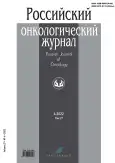Cytodiagnosis of pleural effusions according to the International System for Reporting Serous Fluid Cytopathology: retrospective analysis of oncological dispensary experience
- Authors: Grigoruk O.G.1,2, Vikhlyanov I.V.1, Bazulina L.M.1, Elchaninova S.A.2, Lazarev A.F.2
-
Affiliations:
- Altai Regional Oncological Dispensary
- Altai State Medical University
- Issue: Vol 27, No 4 (2022)
- Pages: 147-156
- Section: Original Study Articles
- URL: https://journals.rcsi.science/1028-9984/article/view/249475
- DOI: https://doi.org/10.17816/onco546017
- ID: 249475
Cite item
Abstract
BACKGROUND: The International Serous Fluid Cytopathology Reporting System (TIS RSFC) was proposed in 2020 to standardize cytological reports and include information on perceived risk of malignancy in reports. It is necessary to analyze the use of TIS RSFC to determine the principles of rational practical implementation and possible improvement of this classification.
AIM: To assess the possibility and results of the application of TIS RSFC (2020) in the cytodiagnosis of pleural effusions using the organizational technologies and resources of a regional oncological dispensary.
METHODS: This observational, retrospective, crossover study carried out a comparative analysis of reports following cytological examination of pleural effusion with clinical and anamnestic information, histological, immunohistochemical results of 1507 patients of the Altai Regional Oncological Dispensary (Barnaul) from 2019 to 2021. The microscope slides were prepared by the traditional smear method, as well as by liquid cytology methods. Papanicolaou and Pappenheim staining methods were used. In certain cases, immunocytochemical tests were performed additionally.
RESULTS: The following numbers of cytological reports corresponding to the TIS RSFC categories were formulated: non-diagnostic material, C I — 11 (0.7%); absence of malignant tumor cells, C II — 946 (62.8%); atypia of unknown significance, C III — 61 (4.0%); suspicion of a malignant process, C IV — 13 (0.9%); malignant process, C V — 476 (31.6%). Within category C V there were 37 (7.8%) cases of the primary tumor — mesothelioma; 398 (83.6%) cases of metastatic tumors, including 41 (8.6%) cases of non-epithelial tumors. Immunocytochemical tests of pleural fluid were performed in 273 (18.1%) cases. Risk of malignancy was 9.1% (1/11) for C I; 1.2% (11/946) — for C II; 59.0% (36/61) — for C III; 84.6% (11/13) — for C IV, and 100% — (476/476) for C V. Cytodiagnosis with immunocytochemistry in unclear cases was characterized by a sensitivity of 92.5%, a specificity of 100%, a positive predictive value of 100%, a negative predictive value of 88.5%, and an accuracy of 96.6%.
CONCLUSIONS: The application of TIS RSFC (2020) in cytological tests of pleural fluid does not cause difficulties for specialists in cytological laboratory. If the required diagnostic accuracy of cytological tests is available, this system makes it possible to characterize the risk of malignancy and thus guide the oncologist in the case management. The liquid-based cytology and the addition of traditional cytological techniques with immunocytochemical tests increase the cytodiagnostic sensitivity.
Full Text
##article.viewOnOriginalSite##About the authors
Olga G. Grigoruk
Altai Regional Oncological Dispensary; Altai State Medical University
Author for correspondence.
Email: cytolakod@rambler.ru
ORCID iD: 0000-0001-9981-2348
SPIN-code: 7250-6259
Dr. Sci. (Bio.), Assistant Professor
Russian Federation, Barnaul; BarnaulIgor V. Vikhlyanov
Altai Regional Oncological Dispensary
Email: akod@zdravalt.ru
MD, Dr. Sci. (Med.)
Russian Federation, BarnaulLarisa M. Bazulina
Altai Regional Oncological Dispensary
Email: lardoc69@mail.ru
ORCID iD: 0000-0002-7222-0657
MD
Russian Federation, BarnaulSvetlana A. Elchaninova
Altai State Medical University
Email: saelch@mail.ru
ORCID iD: 0000-0003-2730-615X
SPIN-code: 9015-4554
Dr. Sci. (Bio.), Professor
Russian Federation, BarnaulAlexandr F. Lazarev
Altai State Medical University
Email: lazarev@akzs.ru
ORCID iD: 0000-0003-1080-5294
SPIN-code: 1161-8387
MD, Dr. Sci. (Med.), Professor
Russian Federation, BarnaulReferences
- Chandra A, Crothers B, Kurtycz D, Schmitt F, editors. The International System for Serous Fluid Cytopathology. Springer; 2020. doi: 10.1007/978-3-030-53908-5
- Hou T, Landon G, Stewart J, Roy-Chowdhuri S. The value of a tiered cytology diagnostic reporting system in assessing the risk of malignancy in indeterminate serous effusions. Cancer Cytopathology. 2021;129(1):75–82. doi: 10.1002/cncy.22345
- Gokozan HN, Harbhajanka A, Lyden S, Michael CW. Root cause analysis of indeterminate diagnoses in serous fluids cytopathology. Diagnostic Cytopathology. 2021;49(5):633–639. doi: 10.1002/dc.24653
- Lobo C, Costa J, Petronilho S, et al. Cytohistological correlation in serous effusions using the newly proposed International System for Reporting Serous Fluid Cytopathology: Experience of an oncological center. Diagnostic Cytopathology. 2021;49(5):596–605. doi: 10.1002/dc.24440
- Xu Y, Hu AY, Wang SM, et al. A retrospective analysis of pleural effusion specimens based on the newly proposed International System for Reporting Serous Fluid Cytopathology. Diagnostic Cytopathology. 2021;49(9):997–1007. doi: 10.1002/dc.24804
- Grigoruk OG, Lazarev AF, Dudarenko SV, Shoikhet YaN. Differential cytological diagnosis of tumor and non-tumor pleural effusions. Barnaul: AZBUKA; 2017. (In Russ).
- Yan-Li Z, Wen-Hao R, Qian W, et al. A retrospective analysis of serous effusions based on the newly proposed international system for reporting serous fluid cytopathology: a report of 3633 cases in an oncological center. Diagnostic Pathology. 2022;17(1). doi: 10.1186/s13000-022-01241-4
- Jha S, Sethy M, Adhya AK. Application of the International System for Reporting Serous Fluid Cytopathology in routine reporting of pleural effusion and assessment of the risk of malignancy. Diagnostic Cytopathology. 2021;49(10):1089–1098. doi: 10.1002/dc.24837
- Pinto D, Cruz E, Branco D, et al. Cytohistological Correlation in Pleural Effusions Based on the International System for Reporting Serous Fluid Cytopathology. Diagnostics. 2021;11(6):1126. doi: 10.3390/diagnostics11061126
- Valerio E, Nunes W, Cardoso J, et al. A 2-year retrospective study on pleural effusions: а cancer centre experience. Cytopathology. 2019;30(6):607–613. doi: 10.1111/cyt.12755
- Farahani SJ, Baloch Z. Are we ready to develop a tiered scheme for the effusion cytology? A comprehensive review and analysis of the literature. Diagnostic Cytopathology. 2019;47(11):1145–1159. doi: 10.1002/dc.24278
- Lee YM, Hwang JY, Son SM, et al. Comparison of diagnostic accuracy between CellprepPlus® and ThinPrep® liquid-based preparations in effusion cytology. Diagnostic Cytopathology. 2014;42(5):384–390. doi: 10.1002/dc.23041
- Ylagan LR, Zhai J. The value of ThinPrep and cytospin preparation in pleural effusion cytological diagnosis of mesothelioma and adenocarcinoma. Diagnostic Cytopathology. 2005;32(3):137–144. doi: 10.1002/dc.20200
- Kinoshita Y, Yuri T, Yoshizawa K, et al. Romanowsky staining using liquid-based cytology: A pilot study using Cytolyt®/HESPANDER® processing solution for ThinPrep® preparations. Diagnostic Cytopathology. 2015;43(12):960–965. doi: 10.1002/dc.23368
Supplementary files











